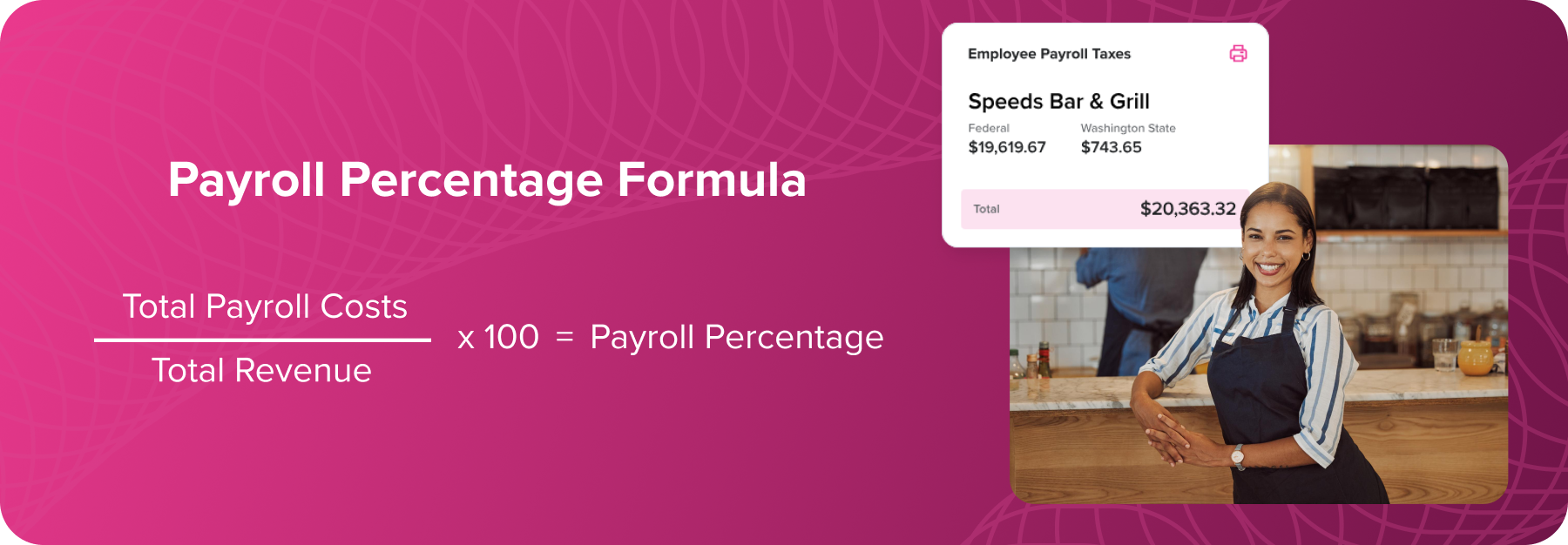Labor is one of the most significant expenses in the restaurant business. Yet, without a clear understanding of your payroll percentage, it’s nearly impossible to know whether you’re overstaffed, understaffed, or operating at peak efficiency.
Payroll percentage isn’t just a number — it’s a vital health indicator for your restaurant, revealing how effectively you’re balancing labor costs with sales revenue. With thin margins and rising labor costs continuing to challenge operators, tracking and improving your payroll percentage has never been more essential.
What Is Payroll Percentage?
Your restaurant payroll percentage is a measure of the portion of your revenue that funds labor costs. Regardless of job code (cooks, managers, servers, etc.), all hourly wages and salaries go into your cost of labor, plus the cost of benefits and payroll taxes. To calculate your payroll percentage, divide your total labor cost by your total revenue and multiply by 100 to display the result as a percentage.
Restaurant Payroll Percentage = Total Payroll Costs / Total Revenue x 100

Your payroll percentage can be tracked through each pay cycle (we recommend weekly payroll) and on longer time frames, such as quarterly or annually. As you actively manage your cost of labor, it’s best to calculate your payroll percentage at frequent intervals.
How to Calculate Payroll Percentage
Using the payroll percentage calculator below, input your Payroll Costs and Revenue to get your restaurant’s payroll percentage.
Importance of Calculating Your Payroll Percentage Accurately
If your payroll percentage is based on incomplete or inaccurate data, even the best decisions can be misinformed. To identify opportunities to reduce your cost of labor, make sure to account for your total labor expenses, including employer-paid taxes, benefits, and any supplemental pay, like tips or bonuses. Overlooking these costs can give you an overly rosy impression of your labor cost, making it harder to spot areas where meaningful improvements can be made.
Finding Opportunities to Optimize Your Restaurant Payroll Percentage
Improving your payroll percentage starts with understanding your current payroll practices and where inefficiencies may be hiding. Many operators struggle with labor overspending — not because they don’t care about cost control, but because they lack the visibility or systems needed to make informed staffing decisions.
To optimize your restaurant payroll percentage, begin by evaluating how your labor is currently scheduled, tracked, and managed. Even small improvements in day-to-day processes can add up to meaningful cost savings over time. In the ideal case, the number of staff on hand should exactly match customer demand. Tracking your sales and labor data in real-time allows you to make accurate determinations of whether your staff is being used optimally.
Beyond the data on your sales in the moment, the best restaurant software can integrate with your point-of-sale (POS) system and pull historical sales data for the current period to make accurate predictions of future demand. These forecasts can enable you to set staffing levels appropriately, minimizing labor cost while supporting the customer experience.
Here are some of the most common areas to review when identifying payroll inefficiencies:

- Scheduling practices: Are schedules being created based on historical sales data and forecasted demand or just gut instinct?
- Overtime management: Are you regularly incurring overtime pay that could be avoided with better planning?
- Real-time labor tracking: Do your managers have access to real-time reports that show how labor spend compares to sales throughout each shift?
- Tip tracking and allocations: Are tips being tracked correctly and transparently to avoid payroll reporting issues?
- Payroll processing systems: Is your current payroll system integrated with your scheduling and POS systems, or are you relying on manual inputs and workarounds?
The more your systems can work together, the easier it becomes to identify gaps and correct inefficiencies.
Proven Strategies for Reducing Restaurant Payroll Costs
Every restaurant, no matter how well-run, will experience fluctuations in labor efficiency. Whether it’s the result of unexpected turnover, seasonal changes in customer demand, or inefficient scheduling practices, payroll costs can creep up without warning. One month, you’re hitting your targets — the next, you’re overstaffed, retraining new hires, or discovering costly payroll errors.
To manage these fluctuations and bring payroll costs back in line, restaurant operators need a toolkit of practical, data-backed strategies. From improving how you schedule and train your staff to implementing technology that automates error-prone tasks, there are many ways to take control of your labor costs without sacrificing service quality.
Here are the most effective strategies to help reduce your restaurant payroll costs:

Reduce Turnover to Maintain Labor Efficiency
Employee turnover is one of the most expensive and disruptive issues in restaurant management. When experienced staff leave, efficiency suffers, especially as new hires take time to learn the ropes. High turnover often leads to inconsistent service, schedule gaps, and training costs that can drive payroll numbers up.
Retaining staff for longer can help protect your training and labor investment. Key drivers of employee retention include:
- Competitive compensation and fair tip structures
- Clear, consistent communication from management
- A safe, respectful, and supportive working environment
Small improvements in workplace culture can result in major gains in payroll efficiency.
Invest in Staff Training to Boost Productivity
Well-trained employees are more productive, confident, and capable of handling busy shifts with fewer errors. When your staff knows how to do their jobs efficiently, fewer employees are needed to deliver a high-quality guest experience.
Rather than relying solely on experience, build structured training programs for every role — servers, cooks, hosts, and beyond. Use your top performers as role models to capture best practices and develop scalable training guides. Even modest efforts to upskill your team can help close performance gaps, reduce labor costs, and get more value from every hour worked.
Find and Correct Payroll Errors
Payroll mistakes — whether due to manual data entry, miscalculated tips, or outdated tax rules — can be costly. Beyond the risk of fines or audits, these errors can also erode trust with your employees and inflate your true labor spend.
Investing in restaurant-specific payroll software can help ensure compliance with local and federal laws, automate calculations for tips and benefits, and integrate with your scheduling and POS systems. This can help eliminate manual work and reduce the risk of overpayments or missing deductions.
Leverage Technology to Streamline Payroll Processes
Modern restaurant management systems can pull data directly from your POS to provide real-time labor insights and historical sales trends. This integration allows managers to:
- Monitor labor percentage throughout a shift
- Build smarter schedules based on demand forecasts
- Distribute tips and manage benefits calculations
- Make real-time staffing decisions to avoid overtime or slow service
If your labor decisions are still driven by spreadsheets or gut instinct, it’s time to upgrade. Data-driven scheduling not only reduces unnecessary payroll costs — it can also help you run a more consistent and responsive operation.
Offer Flexible, Demand-Based Scheduling
Matching staff schedules precisely to guest demand is one of the most effective ways to control labor costs. Instead of building static weekly schedules, consider using sales patterns and shift-level data to shape smarter schedules.
For example, if 6–9 p.m. on Fridays and Saturdays is your peak dinner rush, schedule extra front-of-house support during that exact window (not before or after). When your team is scheduled based on demand, you can minimize downtime and make the most of every labor dollar.
Align Incentives with Operational Goals
Incentivize your staff to work the way that best supports your business. When structured thoughtfully, incentive programs can motivate your team to work more efficiently and take on less desirable shifts, helping you avoid paying premium rates or scrambling to cover gaps.
Consider offering bonuses for roles that are difficult to fill or rewarding team members who consistently meet service benchmarks or pick up high-traffic shifts. Aligning incentives with business goals encourages buy-in from your team and helps reduce the need for costly last-minute scheduling fixes.
Take Control of Your Payroll Percentage
Reducing payroll costs doesn’t require drastic cuts or risky shortcuts — it comes from making smarter, more informed decisions. With the right systems in place, you can improve scheduling accuracy, reduce turnover, and eliminate costly payroll errors, all while supporting a stronger guest experience.
Technology and process improvements play a central role in this process. By automating payroll and integrating your labor data with real-time sales trends, you gain the clarity and control needed to manage your labor costs proactively. If you’re ready to streamline your payroll process and uncover new opportunities for cost savings, automated payroll features through Back Office can make it easier to schedule, track, and pay your team with confidence.
Want to see a real-world example? Listen to our webinar that demonstrates how to control payroll percentage in a wine-by-the-glass program. Discover how smart pricing strategies and Back Office tools that help track performance and optimize offerings can strengthen your restaurant’s bottom line.

